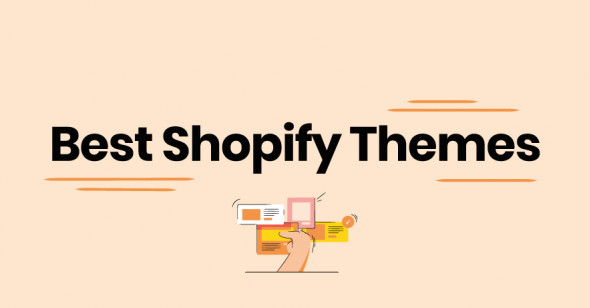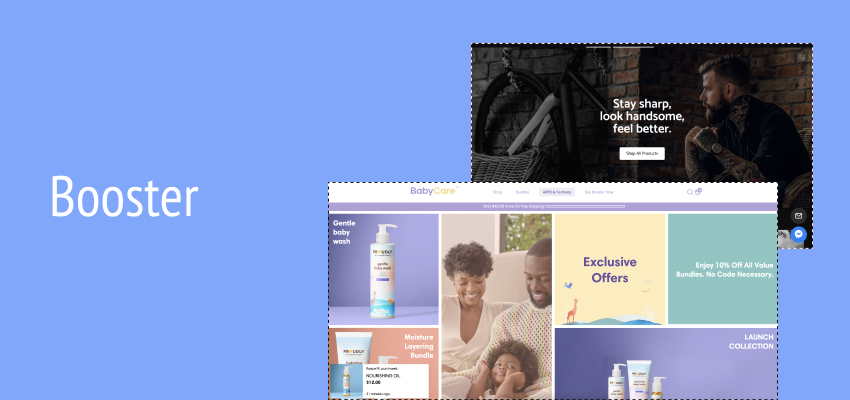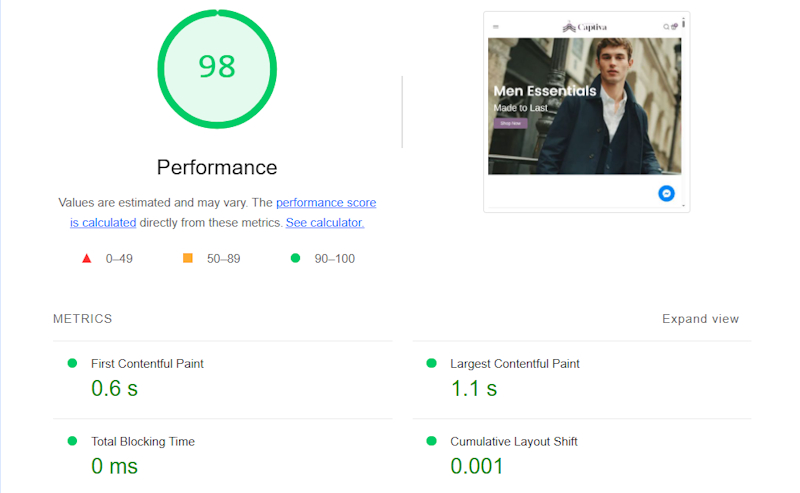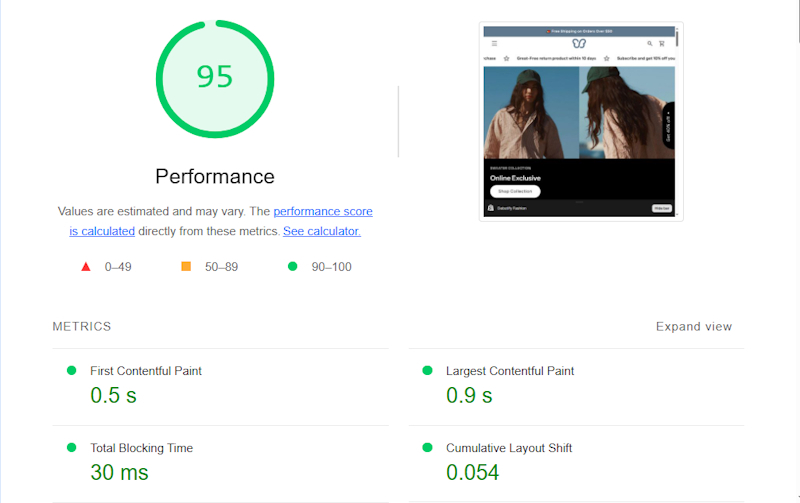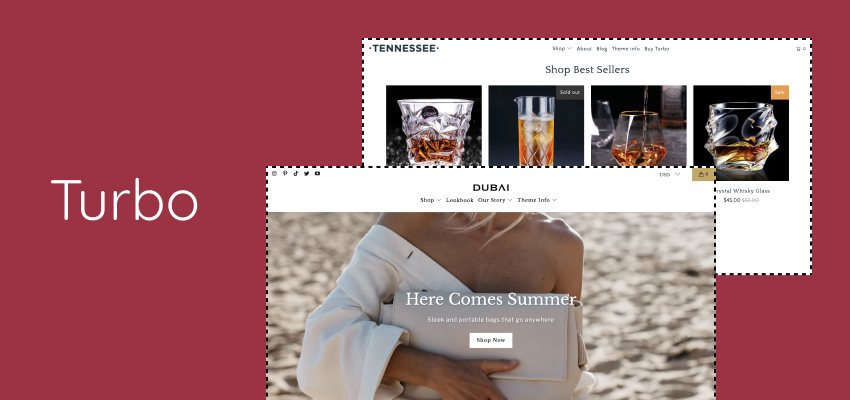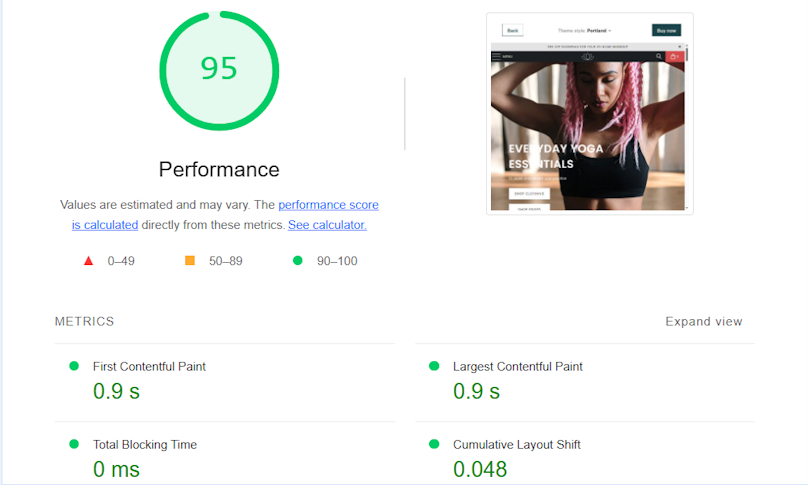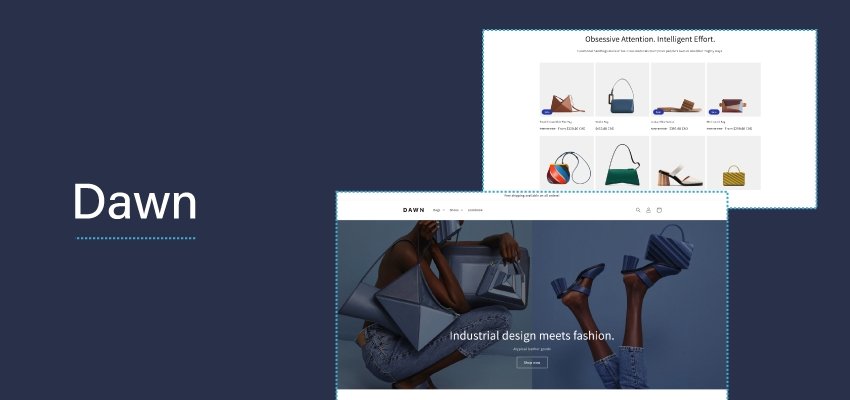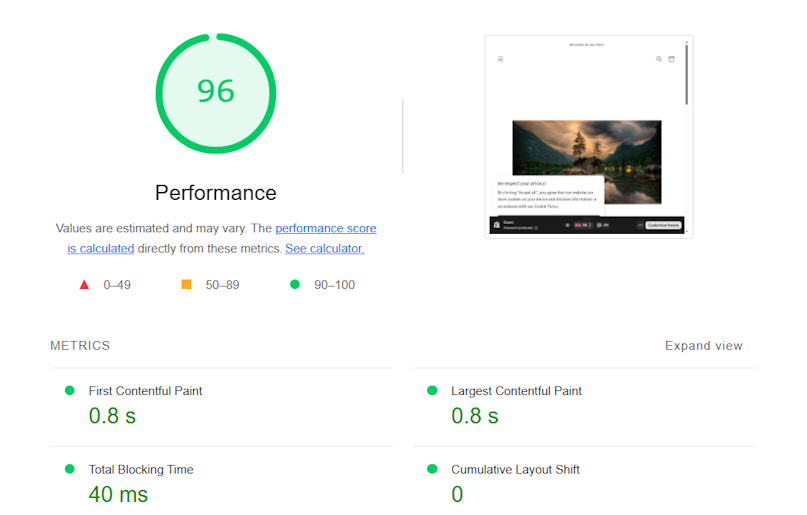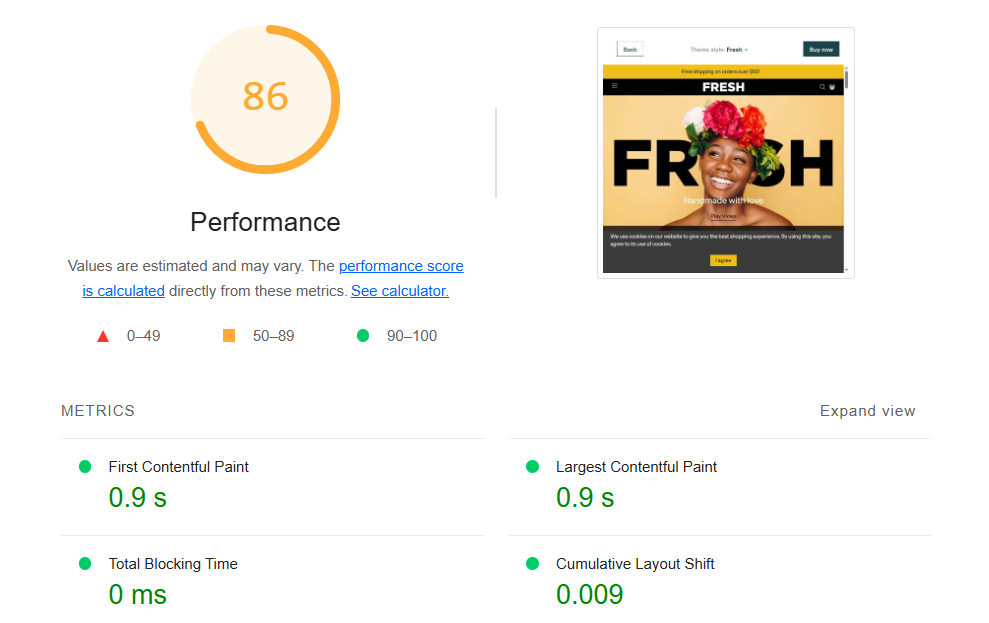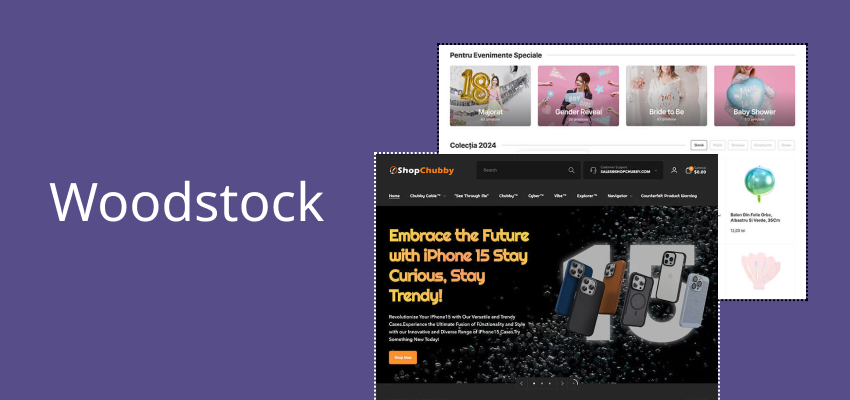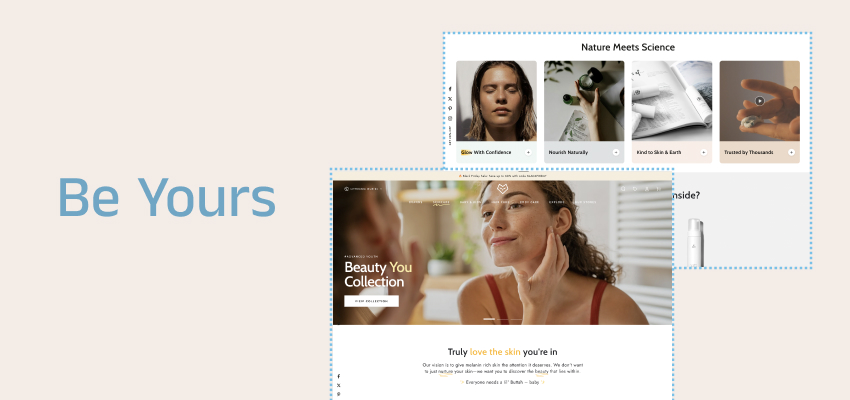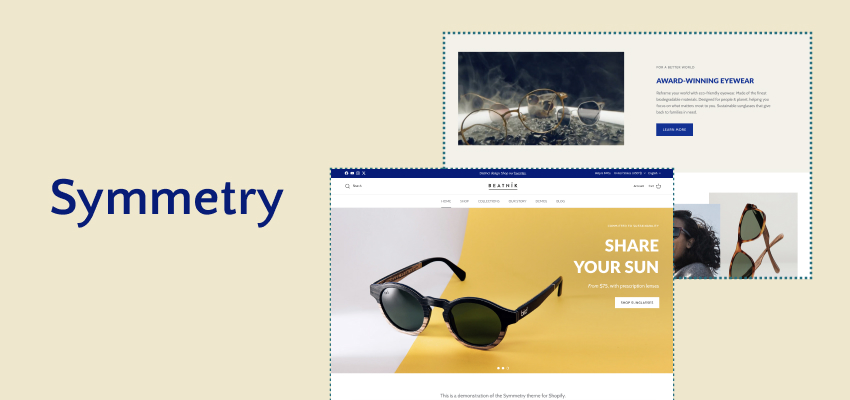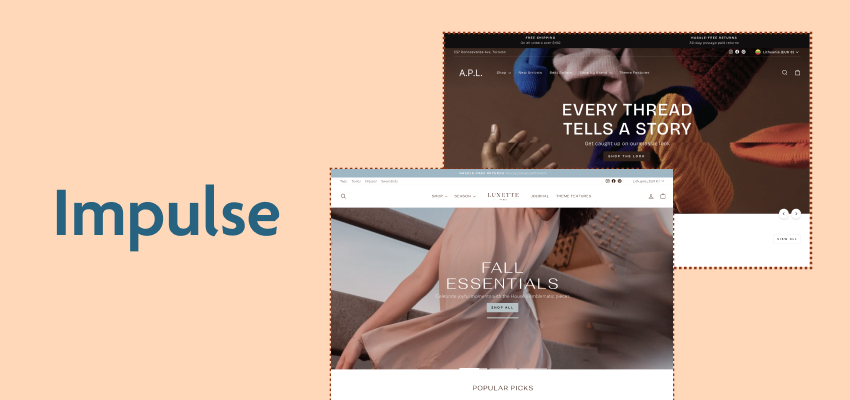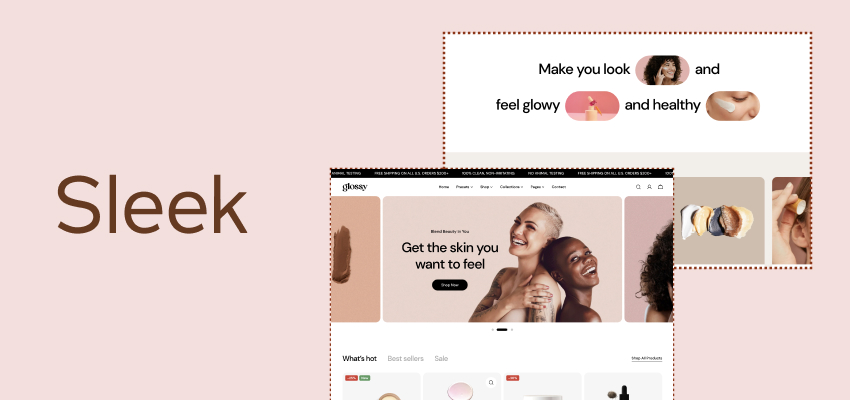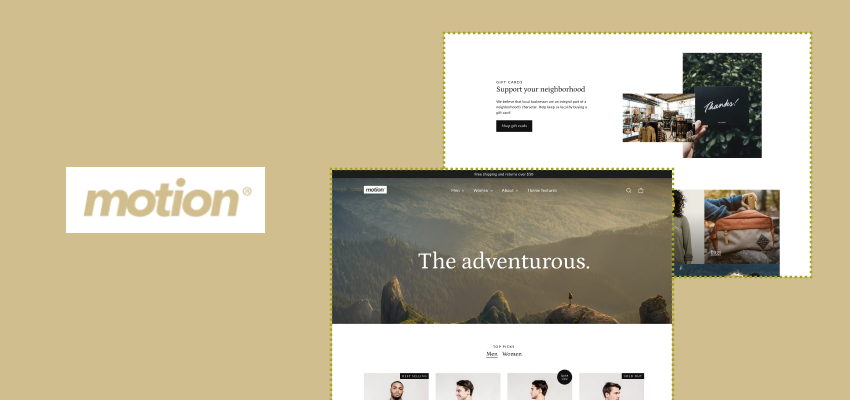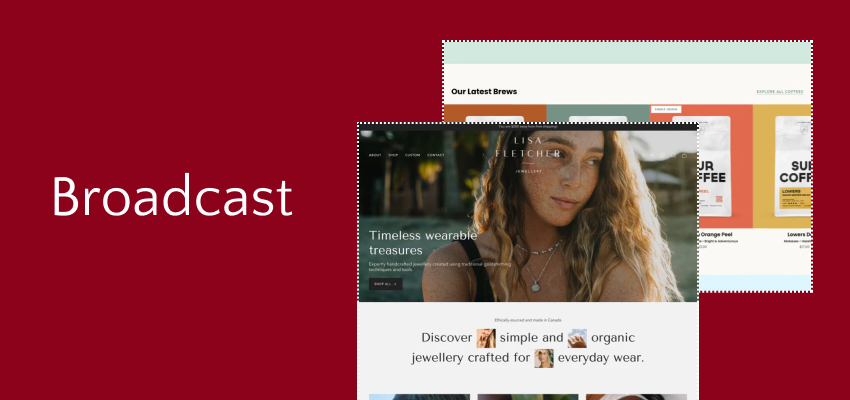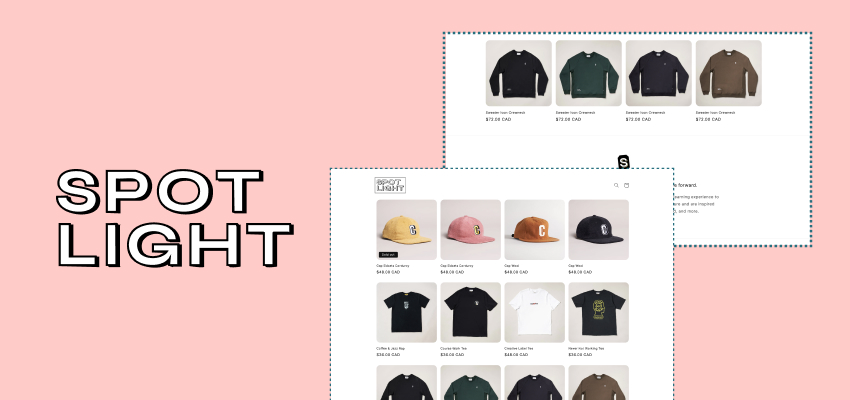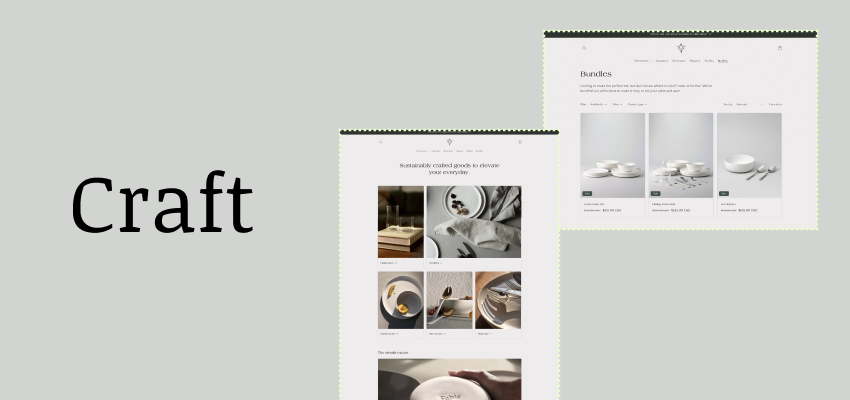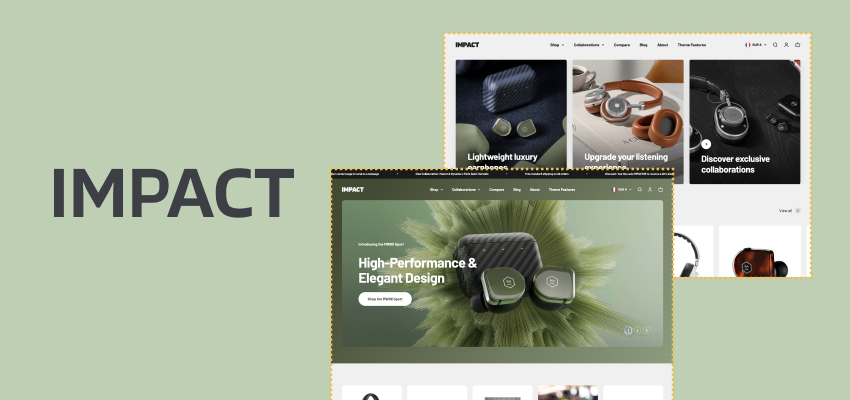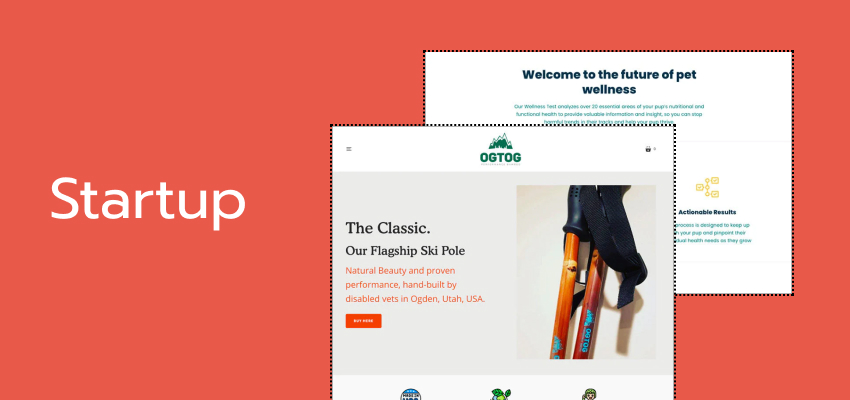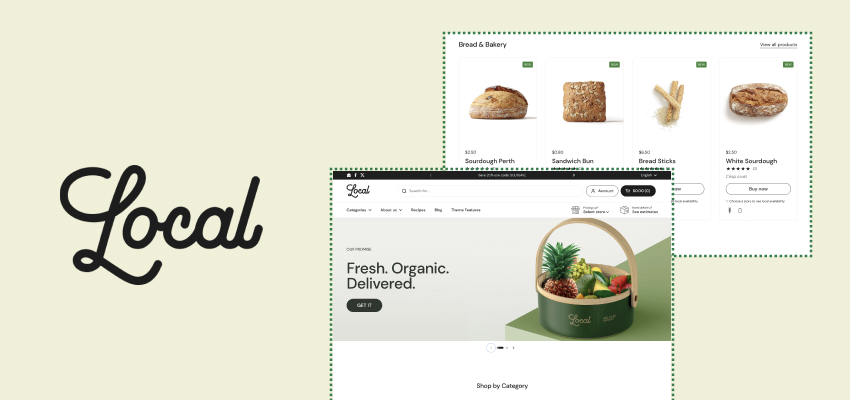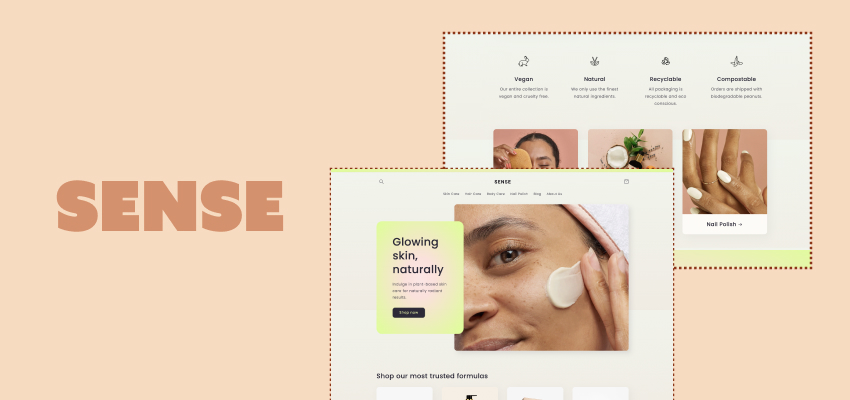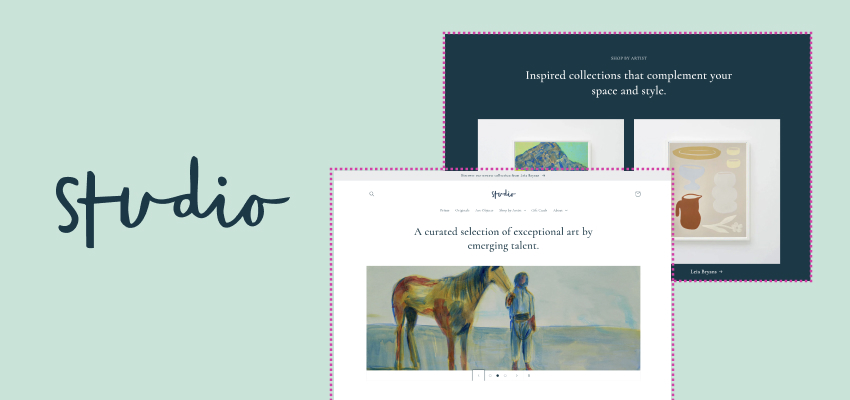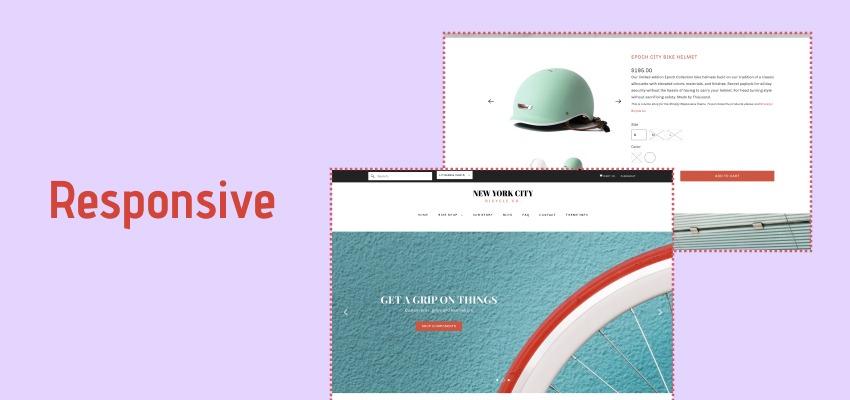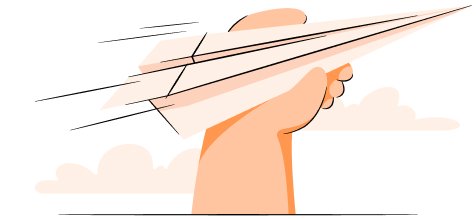Choosing the right Shopify theme goes beyond finding the best-looking design. It should make your store load fast, ensure it’s secure, and work with Shopify’s built-in SEO features.
Even the most aesthetic theme could be damaging to your store’s success and conversions if it lacks in terms of features or loads very slowly.
Me and my team have been testing Shopify themes for over 3 years, so I put the top options in the market to a test. I tested dozens of themes for performance, user-friendliness, and customization to find the best Shopify themes of 2025.
How I tested the best Shopify themes
To find the best Shopify themes, I spent over a month setting up testing websites with each theme. I created basic product pages and a home page, and installed a few apps to record my experience. Then, I waited a few days so Shopify would cache the pages, ensuring I accurately test performance using Google Lighthouse.
Here’s exactly how I tested the themes and what I took into consideration:
- Performance. I tested the performance of the same page of my test stores with each theme using Lighthouse on Chrome. I recorded and compared the results to find the fastest themes.
- User-friendliness. While setting up my test stores, I looked into how easy it was to customize each theme. I took into consideration options for both beginner Shopify merchants and more experienced users.
- Design flexibility. I tried pushing themes to their limit, checking how much customization they allowed. For example, I checked whether themes allowed easily reordering sections, changing fonts, or doing other customizations without needing to code.
- User experience. I reviewed the available navigation features, mimicking the user shopping journey to see how efficient the designs are on both desktop and mobile.
- App compatibility. Considering many merchants use popular Shopify apps like the PageFly page builder or the TinyIMG SEO and speed booster, I reviewed theme compatibility with third-party apps.
- Update regularity. From the themes’ pages, I reviewed the change logs to see how often they release updates. If a theme hasn't been updated in the last 6 months, it was eliminated from the best theme list.
For quick theme detection, you can use Koala Inspector – it reveals which Shopify theme a store is using along with other useful insights.
The best Shopify themes for 2025: in-depth reviews
I researched and tested more than four dozen themes that claim to be the best for specific businesses. Here are the best Shopify themes according to my in-house testing results:
1. Booster – best Shopify theme overall
Notable features:
Lazy loading, image optimizer
Price:
$199/year or $299 for lifetime
Best for:
Upselling and performance
Try theme:
I found Booster to be a the best Shopify theme that can be customized to virtually any niche. There are 80+ presets available for different niches, making it easy to find one that suits your vision.
Why I picked it:
Booster showed great results in terms of performance. Both its desktop and mobile speeds , its mobile performance took me by surprise. Here are the theme’s results:
- Desktop speed score: 98
- Desktop load time (LCP): 1.1s
- Mobile speed score: 84
- Mobile load time (LCP): 2.3s
Booster also comes with some unique features in its arsenal. There’s an image optimizer, lazy loading, a cookie bar, and a copycat preventer. It even works seamlessly with apps like TinyIMG or PageFly.
You can get Booster for $199/year or at $299 for lifetime with a 14-day money-back guarantee.
Who it’s for:
I’d recommend Booster for Shopify store owners who want a theme that will provide a large choice of conversion-oriented elements for their site. It’s a great theme for businesses with multiple niches.
Learn more in our Booster theme review.
Pros
- Good mobile page load time
- Image optimization features
- A cookie bar
- 80+ presets
Cons
- Only 1 year of support for lifetime plan
2. Debutify – versatile Shopify theme
Notable features:
Cookie bar, page speed booster
Price:
Free (paid plans start from $14.50/month)
Best for:
Conversion optimization, beginners
Try theme:
Debutify is another great Shopify theme because it’s versatile and showed excellent page load time and no layout shifts during my in-house tests. It helped me set up my store in a matter of hours and came with 60+ widgets for improving conversions and user experience.
Why I picked it:
Debutify stood out to me because it showed some of the highest desktop performance results during my tests, resulting in a load time below 1 second. Here are the full results:
- Desktop speed score: 95
- Desktop load time (LCP): 0.9s
- Mobile speed score: 70
- Mobile load time (LCP): 3s
I particularly liked that Debutify came with features that I’d need to rely on third-party apps with other themes, like a GDPR cookie bar or a page speed booster. Plus, you can choose from 10 modern-looking layouts.
Debutify has a free plan that’s limited in features, while the premium plans start from $14.50/month.
Who it’s for:
I’d recommend Debutify for medium-to-large sized stores who want a theme with an excellent ratio between speed, functionality, and aesthetics.
You can learn more in our Debutify theme review.
Pros
- Above-average page load time
- 60+ features
- 10 available layouts
- Efficient customer support
- Free plan available
Cons
- Mobile performance could be better
3. Turbo – feature-rich Shopify theme for large stores
Notable features:
Smart page preloading, newsletter popup
Price:
$425
Best for:
High-volume stores, higher sales
Try theme:
Turbo is another great theme for Shopify that lives up to its name in terms of performance and great designs. With 40+ features, including dozens for marketing, you can definitely create a high-converting website.
Why I picked it:
I liked that Turbo offers a page load time that’s just 0.9s, making it one of the fastest Shopify themes out there. Here are my full test results:
- Desktop speed score: 95
- Desktop load time (LCP): 0.9s
- Mobile speed score: 62
- Mobile load time (LCP): 3.8s
I particularly enjoyed finding the Smart page preloading feature – it predicts what users will click next to start preloading the page. Plus, I could choose from 6 premade presets and easily create a newsletter popup or leverage predictive search.
Turbo theme comes at a one-time $425 fee, and you can get a full refund within 14 days of your purchase in case you want to try it out.
Who it’s for:
I suggest Turbo for high-volume stores who want to build a professional-looking and functional Shopify store. While the price point is on the higher side, its feature array, designs, and great customer support make it a worthy contender.
Learn more in our Turbo theme review.
Pros
- Fast page load time
- Smart page preloading feature
- Predictive search
- 6 presets
Cons
- On the pricier side
4. Dawn – the most used free Shopify theme
Notable features:
Nutritional information, in-store pickups
Price:
Free
Best for:
Small budgets, beginners
Try theme:
Dawn is the most popular free Shopify theme out there because it has all the basics covered. With a clutter-free code and a focus on visual storytelling, the theme doesn’t disappoint in terms of both desktop and mobile speeds.
Why I picked it:
I enjoyed how Dawn provides you with all the features you need to help businesses get started. The features don’t even overload the site, making performance great on all devices. Here are the full results:
- Desktop speed score: 96
- Desktop load time (LCP): 0.8s
- Mobile speed score: 93
- Mobile load time (LCP): 2s
Some of the Dawn theme features I found useful were nutritional information, a blog, and in-store pickups. However, the theme doesn’t have features like a GDPR cookie bar. So, if you want to save money on third-party apps, I’d recommend looking into paid themes like Booster.
Who it’s for:
I’d suggest the Dawn theme for merchants who are just starting out on Shopify and have a limited budget. While there are no premium features, the basic functionality combined with excellent performance will help you quickly build a functional site.
Pros
- Completely free
- Excellent performance
- Minimalistic
- Mobile-optimized
Cons
- Only basic features
5. Flex – fast Shopify theme loaded with features
Notable features:
Quick buy, age verifier
Price:
$495
Best for:
Design flexibility
Try theme:
Flex is a premium Shopify theme that comes with good creative freedom and beneficial features for ensuring a user-focused site with great performance.
Why I picked it:
The Flex theme showed great desktop results during my tests, resulting in a 0.9-second load time. On mobile, the load time is 3 seconds, but still higher than the average. Here are my speed test outcomes:
- Desktop speed score: 86
- Desktop load time (LCP): 0.9s
- Mobile speed score: 70
- Mobile load time (LCP): 3s
Flex offers 13 styles you can choose from that are all set up design-wise to go live if you’re looking to publish a site fast. You also get such features like an age verifier, customizable contact form, back-in-stock alerts, and more.
Flex theme styles cost $495, which is on the pricier side, yet I felt like the features, support, and customizability it offers pay off in the long run.
Who it’s for:
Flex is great for freelancers, developers, or other creative merchants who want to build a unique site. It ensures your images are optimized for high quality while maintaining great speeds.
Pros
- Page load time under 1 second
- 13 theme styles
- 4 header and 4 footer styles
- Quick buy feature
Cons
- On the pricier side
6. Woodstock – great Shopify theme for better user experience
Notable features:
Advanced color swatches, gift wrapping
Price:
$270
Best for:
Modern designs, large catalogs
Try theme:
Woodstock made the list of the best Shopify themes I’ve tested because it’s built for speed and is highly oriented to creating a great shopping experience for your customers.
Why I picked it:
Woodstock stood out to me because of its feature-rich arsenal and above average performance. The desktop load times are below 1 second, which is considered a perfect speed. You can see the results below:
- Desktop speed score: 99
- Desktop load time (LCP): 0.7s
- Mobile speed score: 86
- Mobile load time (LCP): 2.8s
I enjoyed the theme’s checkout features, like gift wrapping, in-store pickup, and more. There’s also quite some focus on merchandising, like nutritional information, product videos, or image hotspots.
However, I found it to be less intuitive for beginners. It costs $270 but you can try it for free. If you feel like the theme isn’t as easy to use as you’d like to, I’d recommend opting for Booster or Turbo.
Who it’s for:
I’d suggest Woodstock for dropshippers with large stores that need to build an organized site. With a blog and many checkout-enhancing features, you can find everything needed to create
Pros
- Quick page load time
- 3 presets
- Lots of marketing features
- Good price-to-quality ratio
Cons
- Not as beginner-friendly
7. Be Yours – elegant theme for versatile Shopify stores
Notable features:
Gift wrapping, shipping information
Price:
$320
Best for:
One-product stores, dropshipping
Try theme:
Be Yours made my list of the best Shopify themes because it’s versatile, helping you build a one product store or a giant that sells.
Why I picked it:
My in-house review showed that Be Yours has everything needed to set up a functional site without much reliance on third-party apps. There are features like infinite scroll or in-menu promos that aren’t often offered by their competitors.
Additionally, Lighthouse showed a 0.8s load time on desktop devices during my store tests. The mobile results are a bit closer to average, but that’s to be expected from a media-loaded site. Here are the results:
- Desktop speed score: 97
- Desktop load time (LCP): 0.8s
- Mobile speed score: 75
- Mobile load time (LCP): 3.1s
Be Yours costs $320 which is on the lower price point compared to other popular themes.
Who it’s for:
I’d suggest the Be Yours theme to merchants with dropshipping or one-product stores. It’s flexible enough to handle large catalogs or be set up as a fast and sales-oriented theme for a single product or service.
Pros
- Performance-optimized
- Fast support
- Conversion-oriented
- Many marketing features
Cons
- No wishlist feature
8. Symmetry – mobile-optimized theme for Shopify stores
Notable features:
Animation, sign in with Shop
Price:
$380
Best for:
Light designs, mobile optimization
Try theme:
Symmetry is a conversion-oriented theme that’s popular among Shopify merchants for its fast support, high speed, and mobile-friendliness.
Why I picked it:
I found that Symmetry isn’t just good from my tests – Shopify users also note a seamless experience with the theme. In terms of performance, the theme showed some of the highest results:
- Desktop speed score: 99
- Desktop load time (LCP): 0.7s
- Mobile speed score: 96
- Mobile load time (LCP): 2.6s
To keep performance high, you’ll need to avoid excessively using third-party apps or unoptimized images. The good news is that Symmetry easily integrates with image optimization apps like TinyIMG.
Symmetry costs $380 and you get 4 style options that are highly customizable for many types of niches.
Who it’s for:
I recommend Symmetry for Shopify merchants with large product catalogs that want to create a well-converting site. The diverse feature array will equip you with essential marketing and merchandising functionalities.
Pros
- One of the fastest themes
- Positive customer reviews
- Conversion-oriented theme
- Fast and efficient support
Cons
- No truly unique features
9. Prestige – modern theme for luxury brands
Notable features:
Cross-selling, promo tiles
Price:
$400
Best for:
Luxury brands
Try theme:
I found the Prestige Shopify theme to be a luxurious option for high-end brands that want to ensure a seamless user experience and high conversion rates.
Why I picked it:
What I liked about Prestige most was its high-quality in terms of design. It comes with many features to enhance your pages for conversions, including product badges, quick order list, promo banners and popups, and more.
Performance-wise, the theme showed excellent results on desktop devices, with a load time of just 0.9 seconds. Naturally, mobile load time is a bit slower, but I found that the layout stays responsive on all screens. Here are the performance results:
- Desktop speed score: 99
- Desktop load time (LCP): 0.9s
- Mobile speed score: 77
- Mobile load time (LCP): 3.3s
The theme is frequently updated to ensure a seamless experience. You can get Prestige at a one-time $400 fee.
Who it’s for:
I’d suggest Prestige to brands who want to establish a design-first website, like for fashion, home, or jewelry niches. It’s a great option for medium-sized companies that are focused on a fast and seamless user experience.
Pros
- 30+ sections
- Excellent desktop speeds
- 3 presets
Cons
- On the pricier side
10. Impulse – suitable Shopify theme for large product catalogs
Notable features:
In-store pickups, age verifier
Price:
$400
Best for:
Wide product offerings
Try theme:
Impulse is another sales-oriented theme designed for large catalog stores. It combines 3 modern presets, whopping fast load times, and robust marketing features.
Why I picked it:
I was impressed with the quantity of merchandising and conversion features you can get with Impulse. From running a blog and leveraging animation to promoting your products with banners or pop ups, you can find it all.
Impulse came with some of the speediest page load times on desktop, resulting in an average of 0.7 seconds. As for mobile, while the load time was slower at 3.3 seconds, it’s still an average result for small screens. Here are my full test results:
- Desktop speed score: 99
- Desktop load time (LCP): 0.7s
- Mobile speed score: 77
- Mobile load time (LCP): 3.3s
You can install Impulse to try it for free, but if you want to publish the site, the theme costs $400.
Who it’s for:
I’d recommend Impulse to stores with physical locations or large product catalogs. The theme comes with advanced product filtering, clear navigation, and great speeds.
Pros
- 20+ sections
- Excellent desktop speed
- Loaded with marketing features
Cons
- May be overkill for small catalogs
11. Sleek – easy-to-customize Shopify theme
Notable features:
Gift wrapping, before/after slider
Price:
$350
Best for:
Minimal stores, quick setup
Try theme:
Sleek is another unique-looking theme that is easy to set up and customize even for beginner merchants. It comes with a high quantity of useful checkout and conversion features, from Sign in with Shop and gift wrapping to promo tiles, and more.
Why I picked it:
I picked Sleek because it offers a very clean and flexible design with all of its 5 available presets. No matter how I customized my test store, it always professionally adapted to mobile screens.
However, I felt like a load time of 1.5 seconds is a little low for desktop devices. You can see the Sleek performance results below:
- Desktop speed score: 92
- Desktop load time (LCP): 1.5s
- Mobile speed score: 83
- Mobile load time (LCP): 2.8s
You can get Sleek for $350, but if performance is your top priority, I’d look into themes at a similar price point or cheaper, like Symmetry.
Who it’s for:
I’d suggest getting Sleek for stores that need a creative and modern look to them. It focuses on visual storytelling and a high product catalog, helping set up a visually appealing and conversion-oriented store in a matter of hours.
Pros
- Quick setup
- Many conversion features
- User-friendly
Cons
- Performance results could be better
12. Motion – Shopify theme suitable for video content
Notable features:
Shipping information, usage information
Price:
$400
Best for:
Video content
Try theme:
Motion is a Shopify theme that’s suitable for stores that want to showcase video content. It supports animations and video embeds with 3 different layouts to customize to your vision.
Why I picked it:
What stood out to me during testing was Motion’s ability to keep customization simple. You can set up premium-looking catalogs with engaging videos at a one-time $400 fee.
Here’s an overview of how Motion performed during my tests:
- Desktop speed score: 88
- Desktop load time (LCP): 1.8s
- Mobile speed score: 62
- Mobile load time (LCP): 3.9s
Although desktop performance was great, mobile load times could’ve been faster. Yet, the results fall into the average space, so the ultimate performance will depend on how you set up your store.
Who it’s for:
I’d suggest Motion to brands who rely on video content or storytelling to sell products, such as gardening or outdoor niches. It’s a suitable choice for creating medium to large-sized catalogs with simple navigation.
Pros
- 20+ sections
- Animation and video-oriented
- Rich in features
Cons
- Slower mobile speed
13. Broadcast – mobile-first theme for Shopify stores
Notable features:
Sign in with Shop, translations
Price:
$400
Best for:
Direct-to-consumer brands
Try theme:
Broadcast is a flexible theme that’s optimized for mobile, helping you create a seamless shopping experience on any device.
Why I picked it:
I chose Broadcast as one of the best Shopify themes because it’s fast, highly customizable and has a luxurious design. During my in-house tests, I discovered a great page load time of 0.7 seconds on desktop and 2.7 seconds on mobile. You can see the main results here:
- Desktop speed score: 98
- Desktop load time (LCP): 0.7s
- Mobile speed score: 81
- Mobile load time (LCP): 2.7s
With this theme, you get features like Sign in with Shop, product badges, color swatches, and more. While there aren’t many unique features, you get everything needed for a functional site. So, whether the $400 price point is worth the price depends on your site needs.
Who it’s for:
I’d suggest opting for Broadcast for Shopify merchants that have a product-loaded store with a physical location. It’s mobile-optimized, ensuring your customers can enjoy a seamless shopping journey on any device.
Pros
- Fast page load time
- Great for large stores
- Good support
- Conversion-focused
Cons
- On the pricier side
14. Spotlight – Shopify theme that's beginner-oriented
Notable features:
Quick setup, sticky header
Price:
Free
Best for:
Startups, quick launching
Try theme:
I chose the Spotlight theme because it’s a great beginner-focused theme with all necessities covered. It balances performance and efficient design to help set up a store in minutes.
Why I picked it:
I have to give praise to Spotlight because as a free theme, it showed excellent page load time results during my in-house tests.
- Desktop speed score: 99
- Desktop load time (LCP): 0.7s
- Mobile speed score: 96
- Mobile load time (LCP): 2.6s
However, keep in mind that this theme is basic in terms of features, offering just regular merchandising features, like color swatches or size charts. If you need to build a more complex store, you’ll likely have to invest in third-party apps which can overload your store. In such cases, I’d recommend looking into themes with premium features, like Booster or Turbo.
Who it’s for:
Spotlight is a suitable theme for merchants who want to launch a functional and minimalist site as soon as possible. It may not have premium features available, but it lets you create a clean and simple site fast.
Pros
- Excellent performance
- Basic features
- Quick setup
- Completely free theme
Cons
- Poor customer support
- Limited features
15. Craft – free Shopify theme for small stores
Notable features:
Quick setup, in-store pickups
Price:
Free
Best for:
Handmade products or small catalogs
Try theme:
Craft is another Shopify theme that’s one of the popular choices among merchants on a budget. It’s free, optimized for performance, and respects Shopify’s native SEO functionality.
Why I picked it:
The Craft theme’s popularity lies in its authentic designs and advanced customization options. I liked that it allows a quick store setup and shows good performance results during my in-house tests with a page load time below 1 second on desktop. You can see the performance results below:
- Desktop speed score: 99
- Desktop load time (LCP): 0.7s
- Mobile speed score: 93
- Mobile load time (LCP): 2.8s
What I found to be a drawback with Craft is the lack of presets, but that’s expected with a free theme. Plus, support isn’t as good as with premium themes like Booster considering you may have to wait much longer for a reply.
Who it’s for:
While it’s not the perfect choice for medium or large stores, I’d recommend Craft for beginner shops with a focus on storytelling. It’s a free theme with basic features, like blogs, cross-selling, and color swatches, that will help you build a simple functional store.
Pros
- Page load time under 1 second
- Quick setup option
- Aesthetic designs
- Essential features, like blog
Cons
- Support is slow
- No presets available
16. Impact – theme for stores with editorial content
Notable features:
Translations, product badges
Price:
$400
Best for:
Bold designs, large catalogs
Try theme:
I chose Impact as one of the best Shopify themes because it doesn’t just ensure a convenient shopping journey for users – it’s also optimized for editorial content.
Why I picked it:
Impact theme is loaded with merchandising features, so you can find product videos, usage information, before and after sliders, and more. You can easily create detailed content about your products or run a blog, as the design is optimized for storytelling.
My in-house tests showed that Impact performance is excellent on desktop with a 1-second page load time. Meanwhile, I found that mobile results could use some optimizing. Here’s what I got:
- Desktop speed score: 98
- Desktop load time (LCP): 1s
- Mobile speed score: 83
- Mobile load time (LCP): 3.4s
Impact costs $400 which I feel is a decent price point for a theme that’s packed with 35+ sections and is optimized for conversion.
Who it’s for:
I’d recommend Impact for medium to large businesses with loads of products that are focused on increasing conversions. It’s a modern theme that’s intuitive and offers great product discovery functionality.
Pros
- Fast page load time
- Great for large stores
- Good support
- Conversion-focused
Cons
- Mobile performance could be improved
- On the pricier side
17. Startup – great theme for beginner businesses
Notable features:
Age verifier, promo banners
Price:
$100
Best for:
Smaller budgets, single products
Try theme:
Startup is a budget-friendly premium Shopify theme that comes at just $100. It has 4 example prests and is made for a quick launch of a customer-oriented site.
Why I picked it:
I liked that Startup is focused on small businesses that are just starting out. You get such features as in-store pickups, age verifier, FAQ page, recommended products, and more to help you get a successful kick start.
During my in-house tests, I found that Startup loads in over 2 seconds on desktop, so if speed is a priority, I’d look into themes like Booster or Turbo. You can overview my findings here:
- Desktop speed score: 81
- Desktop load time (LCP): 2.1s
- Mobile speed score: 77
- Mobile load time (LCP): 2.7s
However, the main drawback for me was the basic features you get, which are usually already included with free Shopify themes.
Who it’s for:
I’d recommend the Startup theme for companies that are just starting out and have a small product catalog. Considering the $100 price point, it’s a good option for creating a small store with a great user experience.
Pros
- Good page load time
- Budget-friendly
- Basic features
Cons
- No premium features
- Desktop load time could be better
18. Local – food industry theme for Shopify stores
Notable features:
Sign in with Shop, gift wrapping
Price:
$360
Best for:
Food industry websites
Try theme:
I added Local to the best Shopify theme list because it’s a community-oriented option, offering features focused on stores with physical locations and fast desktop load times.
Why I picked it:
The Local theme comes with many features to make your store convenient for customers. You can get a stock counter, right-to-left, animation, shipping information, back-to-top button, and many other useful features.
My in-house testing of the Local theme showed a good average load time of 1.3 seconds on desktop, but I disliked the mobile load time at 4.6 seconds. Here are the full results:
- Desktop speed score: 97
- Desktop load time (LCP): 1.2s
- Mobile speed score: 81
- Mobile load time (LCP): 4.6s
Local comes at a one-time $360 fee. I feel like it’s a fair price considering its features and support efficiency. Plus, you can try it out and customize it completely free – you can pay when you publish.
Who it’s for:
I suggest Local for merchants with medium to large-sized stores in the food industry, especially for those with local stores. It’s a highly customizable theme with 4 presets and 25+ sections to pick from.
Pros
- Great page load time
- Works for age-restricted products
- Highly rated customer support
Cons
- Food industry-specific theme
- Mobile speeds need improving
19. Sense – free theme for small companies with bright designs
Notable features:
Usage information, shipping information
Price:
Free
Best for:
Beauty niche, visual storytelling
Try theme:
Sense is a theme that’s oriented towards Shopify stores with a bright and clean design. As a free theme, it offers the basic features needed to set up a simple yet speed-optimized store.
Why I picked it:
Sense offered above-average performance scores and load time results during my tests with Google Lighthouse. A desktop load time of just 0.6s was one of the fastest I’ve tested. Here are the theme results:
- Desktop speed score: 99
- Desktop load time (LCP): 0.6s
- Mobile speed score: 92
- Mobile load time (LCP): 2.1s
With Sense, you have space to dive into the technicalities of your products. You can add ingredients, nutritional or usage information, or further enhance the product pages with shipping information or product videos. However, I lacked unique features, like trust badges or Sign in with Shop.
Who it’s for:
I’d recommend Sense for small companies that want to create engaging product pages and make their products stand out. It’s a theme that ensures a great user experience with good speeds and advanced customization options.
Pros
- Advanced customization
- Soft and bright color palette
- Many merchandising features
Cons
- Slow customer support
- No preset choices
20. Studio – organized theme for Shopify artists
Notable features:
Shipping information, product options
Price:
Free
Best for:
Artists, collectors
Try theme:
I included Studio in the best Shopify theme list as it’s a great option for stores that want to achieve an artistic look and focus on visual storytelling. It’s a free theme that is optimized for speed and SEO according to best Shopify practices.
Why I picked it:
Once I set up my test store with Studio, I found it to be a very minimalist theme that’s easy to customize even for complete beginners. Its performance didn’t disappoint me during my testing either. With a 0.7-second load time on desktop, bounce rates caused by low speeds won’t be an issue. Here are the results:
- Desktop speed score: 98
- Desktop load time (LCP): 0.7s
- Mobile speed score: 93
- Mobile load time (LCP): 2.2s
What I disliked with Studio is the lack of product filtering and advanced conversion features like cross-selling or upselling. Yet, this could be a disadvantage for larger stores only, but Studio is tailored towards smaller businesses.
Who it’s for:
I’d recommend Studio for artists who want to showcase their portfolio or art collectors. It’s a theme for stores with smaller but clean and colorful product catalogs.
Pros
- Focused on collections
- Flexible layout
- Basic features included
Cons
- Limited to small stores
- No preset choices
21. Responsive – highly customizable Shopify theme
Notable features:
Back-in-stock alert, translations
Price:
$240
Best for:
High-quality visuals
Try theme:
The Responsive Shopify theme is a highly customizable option with 4 available presets to help customize your store according to your vision.
Why I picked it:
The Responsive theme made setting up a basic product page during my testing very simple, so beginners at website building won’t get lost. For a $240 one-time fee, it offers some features, like in-store pickups, that make it suitable for companies with physical locations.
In terms of speed, my Google Lighthouse tests showed decent performance on desktop. You can see the full results below:
- Desktop speed score: 86
- Desktop load time (LCP): 1.9s
- Mobile speed score: 65
- Mobile load time (LCP): 7.5s
However, I wasn’t impressed with the mobile performance. A 7.5-second load time could result in high bounce rates, so I’d recommend faster themes like Booster for mobile-oriented sites.
Who it’s for:
I’d suggest getting the Responsive theme for established businesses with a medium-to-large product catalog. It offers multiple modern-looking presets that make your website look professional on any device.
Pros
- Wide layout
- Highly customizable
- Basic features included
Cons
- Mobile performance could be better
- No unique features
What makes a Shopify theme great?
What makes a Shopify theme great depends on what the merchant is looking for and the business niche. However, there are some key features that are a no-brainer when choosing a Shopify theme. Here’s our criteria:
- Responsive design. While most popular Shopify themes claim they’re optimized for mobile devices, you should always check how the theme looks on different screens, and evaluate if it meets your standards.
- Flexible customization options. A great theme should be highly customizable without having to touch code. Look out for themes with integrated builders that allow you to edit/add/remove sections, elements, navigation menus, and so on.
- Sales features. Promotional, upselling, and other conversion features can greatly contribute to successful business growth. Look for a theme that offers product discount labels, newsletter popups, promo banners, and other sales-boosting features.
- Clear checkout process. The best themes will aim to keep cart abandonment as low as possible, creating a clear and simple checkout process.
- Performance. Top Shopify themes must load fast and ensure no layout shifts to create an uninterrupted user experience, so your site keeps bounce rates low.
Most themes won’t offer you every single feature you may need in the future. Consider reviewing the best Shopify apps for automating tasks, improving SEO, email marketing, or user experience, and more.
Summary
Finding the right Shopify theme means choosing an option that balances speeds, user experience, responsiveness, design flexibility, and many other factors.
My in-house testing showed that Booster is the best Shopify theme because its fast loading speeds, 80+ modern presets, and powerful marketing tools are very hard to match.
However, our list includes many other great themes that are optimized for performance and offer professional designs. The ultimate best option depends on your niche and business needs.
Frequently asked questions
The best theme for Shopify is Booster. It offers 80+ design presets for different niches and fast loading speeds of just 1.1 seconds. Plus, it comes with dozens of marketing tools – all focused on helping business owners boost conversion rates and increase traffic.
The best converting Shopify theme is Booster. With dozens of widgets, including a promotion timer, GDPR cookie bar, quick buy, and copycat stopper, it focuses on helping business owners enhance the user experience and optimize sales.
Booster is one of the most customizable Shopify themes. There are dozens of features, with many of them allowing you to create a user experience and conversion-oriented design. This includes adding a mega menu, infinite scroll, sales increaser, cookie bar, and more.
Yes. Paid Shopify themes are worth the squeeze as they would grant you access to the juiciest tools and new releases to catch up with the latest trends. However, make sure that the paid theme has good customer service as your success may depend on it in the long-run.
